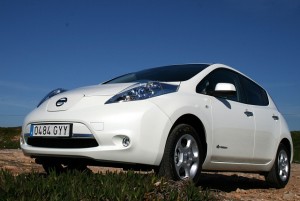It was clear that the motorcycle Polícia wanted a word when we pulled up at a red light in Lisbon. False alarm; he wanted to know what we thought of the Nissan LEAF we were driving. He knew it was electric and asked about its range and what it's like to drive. Finally we're able to definitely answer those things about Nissan's new electric car.
In the Metal
We bagged one of the few white cars available to drive, as every picture of every Nissan LEAF to date has been blue. The pearlescent white paintwork suits the car, though being brutally honest, it's not good-looking. At best it's interesting, but from some angles it's downright weird. Still, at least those early adopters will stand out in a crowded car park...
The LEAF's interior is much more conventional; and distinctly spacious. There's loads of head- and legroom, regardless of where you sit, and the boot holds 330 litres. That's not far off a VW Golf's, though the LEAF's split-folding rear seats do not create a completely flat load space when tilted forward.
Nissan has done a good job on the interior quality, with plenty of textured plastics and soft-touch materials, along with tactile switchgear. Despite the inclusion of a few unusual new read-outs, it's quite an intuitive layout, though we're not fans of the strange drive selector. It's easy to use, but a little too 'digital'. The seats are supportive enough, but it's disappointing that the steering only adjusts for rake and not reach.
What you get for your Money
To simplify things for the buyer (and Nissan's factory no doubt), the LEAF will be available in a single well-specified grade only to begin with. Highlights include the nicely integrated satnav and climate control systems, plus a rear parking camera. Smartphone connectivity allows owners to carry out a variety of tasks such as scheduling charging and pre-setting the temperature of the car, as well as receiving notifications.
Nissan Ireland has already taken about 500 orders for the LEAF. It costs €29,995 including the Government grant for electric vehicles. That's still considerably more than any regular Ford Focus or VW Golf, though Nissan counters it with estimated running costs of about two cents per kilometre (in comparison to about eight cents per kilometre in a modern turbodiesel car). Additionally, maintenance costs are about 15 percent lower than a conventional car's because of the massive reduction in the number of moving parts.
Range anxiety is a phrase invented for the advent of electric cars. Nissan admits that the LEAF is not for drivers that regularly travel hundreds of miles in a day, but it should suit the majority of us. Obviously the real range varies according to several factors, including how the car is driven, the lay of the land and the use of the climate control. Nissan reckons 76 kilometres is the worst case scenario (high speed cruising on the motorway) and that the best is around 220 kilometres. We covered about 120 kilometres on roads including the city, a fast motorway and a winding country route, and an estimated sixty kilometres or so remained 'in the tank'.
Driving it
All the things we're learning to accept about electric cars are present and correct in the LEAF. So you can take for granted that it's quiet and has its full torque available from a standstill. However, Nissan has made tangible gains in the LEAF's refinement moving from the pre-production model we drove earlier in the year. It's very well isolated from the outside world, with only a faint whistle from the motor when accelerating hard or uphill.
And accelerate it does. Nissan quotes an 11.9-second 0-100km/h time, but that feels quite conservative, as the LEAF quickly and cleanly gets off the line and effortlessly gets up to speed. It maintains this easily and it turns out to be a truly relaxing car to drive. All of the controls are light (the steering a little too much perhaps) and the damping is particularly well-judged, soaking up bumps and ridges in a mature manner.
Yet the LEAF isn't all at sea when it comes to a series of corners. It exhibits remarkably little body roll and adopts a neutral stance through the bend. The brakes are strong, if a tad strangely modulated, but there's little in the way of feedback from the steering or tyres. However, it's a competent handler and there's something really enjoyable about the way it goes down the road. In short, it majors on comfort, but its owners should still actively enjoy driving it.
Worth Noting
Nissan is all too aware of the ongoing debate about the life of electric car batteries. It will include the laminated lithium ion battery pack in the purchase price of the LEAF. This is in contrast to Renault's plans for the Fluence Z.E. Remember that Nissan and Renault are part of the 'Alliance'. When quizzed on this, Nissan's management admitted that there is no right or wrong way to do things, as electric cars are still in their infancy. Nissan also said that the Alliance allows it to try out different approaches and adopt a single one if it turns out to be the most advantageous. It was also noted that it would technically be possible to swap the battery for a new one if technology moves on.
Summary
We didn't go to what amounts to our third or fourth experience of the Nissan LEAF expecting a surprise, but the finished product is just that. Obviously its range limitations will not suit all drivers, but stats suggest that it would cover average needs. Our main criticisms of the car (namely its exterior styling and overly light steering) could just have easily been applied to a regular vehicle. Has the day of the electric car arrived? We think so.


